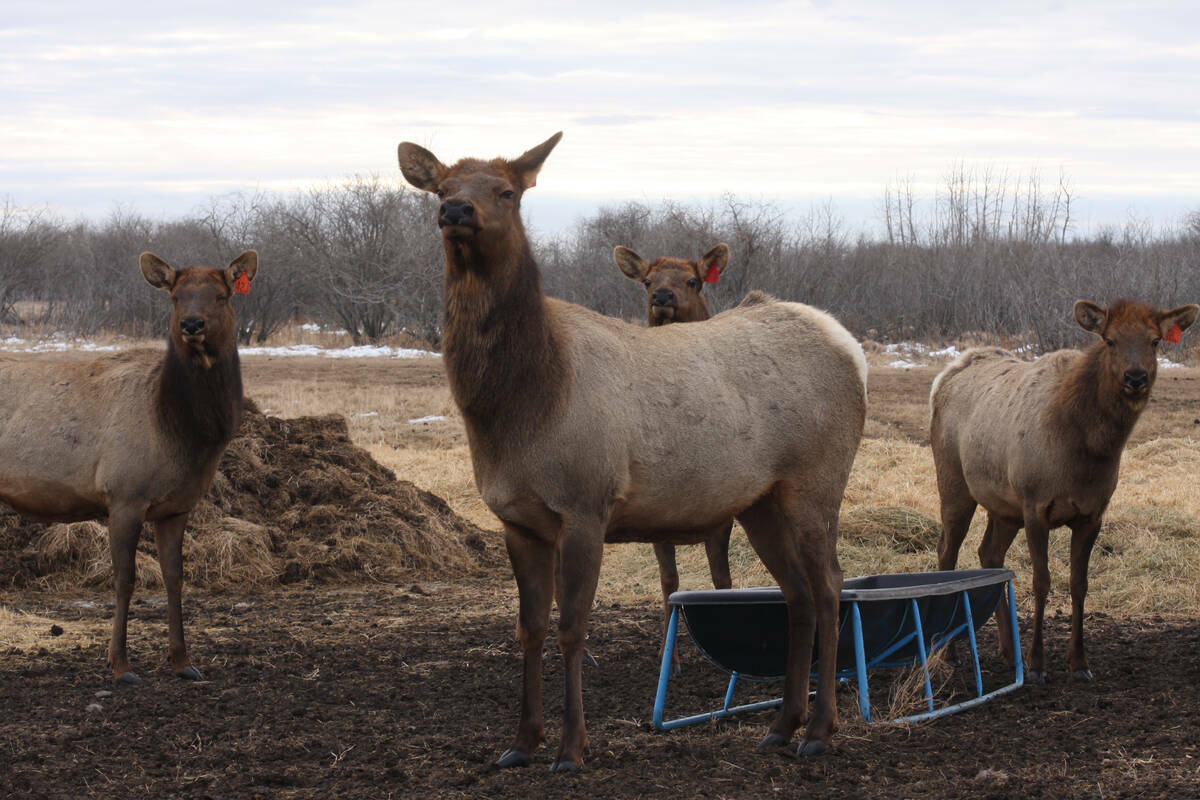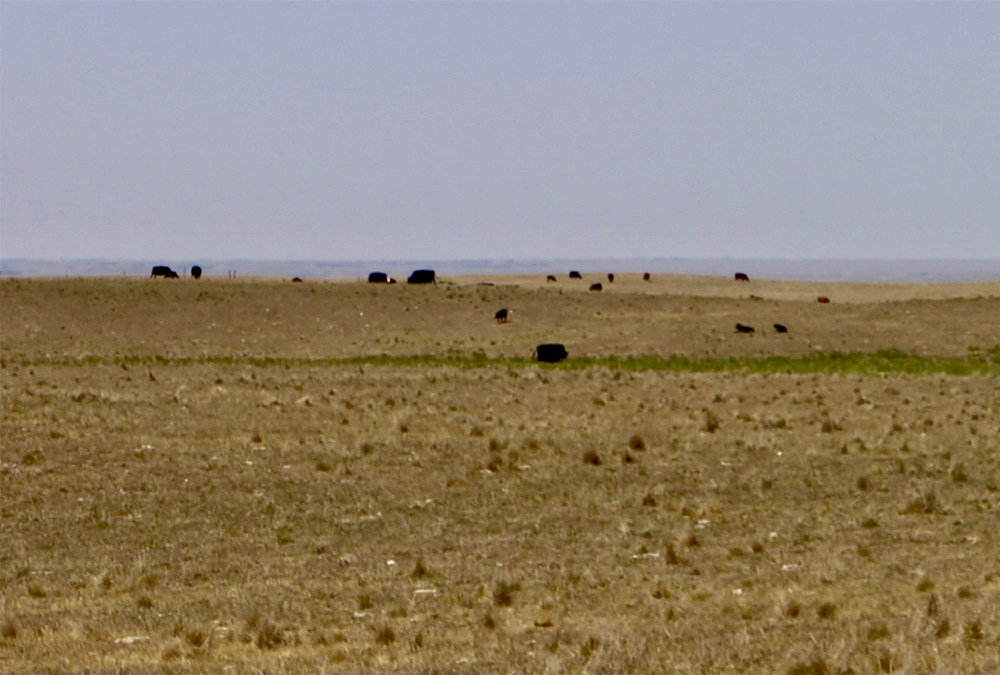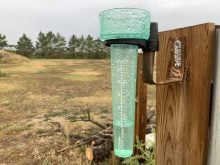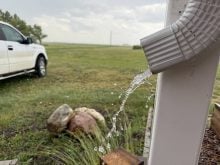Grasshoppers have been chewing their way through hay and other crops all over southern and central Alberta.
But in some areas, even grasshoppers have nothing to eat in dry pastures and hay fields.
That’s the case with southeast Alberta rancher Brad Osadczuk. And he’s not alone.

“I think grasshoppers are looking for green vegetation and there’s no green vegetation left. They’re moving on. We don’t have enough green to even satisfy the grasshoppers at this point. (The pastures) turned brown before they got to us,” said Osadczuk, who ranches 65 kilometres east of Brooks in Alberta’s Special Areas.
Read Also

Cervid harvest preserves to be developed in the province under Bill 10
The Government of Alberta has given approval for creation of cervid harvest preserves.
In his whole adult life, Osadczuk has never seen rainfall in such short supply as it has been over the last 12 months — not even during the drought of 2021. And he knows, because he measures it.
“We really haven’t had a significant amount of rain at one time since this time last year, and I’m not exaggerating,” he said. “I think it was July 18 (last year) that we had maybe an inch-and-a-half of rain in a thunderstorm. And that was the last time we had a significant amount.
”So yeah, it’s bad. It’s really bad.”
Little wonder, then, that the Special Areas Board declared a state of agricultural disaster for Special Areas 2, 3 and 4 on July 12, a little over a month since the eastern Alberta County of Stettler did so June 14.
The Special Areas covers more than five million acres in east-central Alberta. The region has been coping with significant dryness for years, and also declared an agricultural disaster in 2021.
“Dry conditions are not new to the Special Areas, but ongoing moisture deficiencies and hot temperatures have devastated crops and pasture throughout the region,” wrote Jordon Christianson, Special Areas chair, in a news release.
“Producers are struggling to find enough grass, water and feed for their cattle. Farmers are facing widespread crop failures. Significant grasshopper infestations are making a very difficult situation worse in many parts of the Special Areas.
“Declaring an agricultural disaster is one way we can raise awareness of how serious this problem is with the province and with the federal government.”
Producers need cash in hand and they need it quickly.
“Obviously, speed matters,” said Sheila Hillmer, vice-chair of Alberta Beef Producers. “We want to keep the cow-calf producers able to keep their cattle. There are some cow-calf producers that still haven’t been able to bring cattle back onto their operation since 2021. And they still haven’t had adequate rainfall and opportunity to repopulate.”

Cumbersome process
The Agricultural Financial Services Corporation (AFSC) and the federal government are listening, said Emmet Hanrahan with the federal-territorial-provincial farm lending and insurance company.
Various commodity groups and AFSC are working with the federal government to see if AgriRecovery, a business risk management tool from AFSC that offers protection against extraordinary losses, could be used to respond quickly to situations where there are gaps in other programming, he said.
However, that could be a lengthy process. In the meantime, Hanrahan said there are other AFSC tools designed to help producers weather the challenges of drought and infestation.
The Moisture Deficiency Insurance program for pasture compensates producers when accumulated precipitation falls below what is considered normal for a given area. It recently moved to a monthly payment schedule, said Hanrahan.

“We’ve got about 8.5 million acres insured under the Moisture Deficiency Insurance program. And just in May of this year, it paid out just over $65 million for 3,000 clients. And then in June, it paid out $85 million over 7,800 clients,” he said.
“That just really shows that it’s working and it’s getting money out there quickly for producers that are short on pasture.”
Hanrahan recommended that farmers look into the Low Yield Allowance feature under AFSC’s crop insurance program. It’s essentially an incentive to sell failed crops into the livestock feed market.
This year, the organization doubled the program’s threshold values for producers who salvaged cereal or pulse crops as feed. For example, the barley crop threshold has increased from 150 to 300 kilograms per acre.
“We’ve doubled that low yield allowance so that producers will be encouraged to consider taking those crops for feed,” said Hanrahan, who encourages producers to contact their local AFSC office to see if they have a risk management solution that’s right for them.
Shannon Sereda, with the Alberta Wheat and Barley Commissions, said there has been concerted effort on AFSC’s part to be more responsive to the needs of producers facing financial difficulties.

“By working with AFSC and all the crop commissions, I know that they are trying to make improvements to responsiveness, expediting payments and doing timely adjustments,” she said.
“That’s something that we’ve continually been working with them on because those have been concerns in the past, but we definitely have seen some improvement.”
Osadczuk prefers the “tweaking” of existing government risk management solutions rather than devising new programs that may do little more than throw money at the problem.
“Handing out money isn’t the answer. What we’re trying to prevent here is a shrinking cow herd in Alberta. But we do need some kind of support and I don’t know what that’s going to look like.
“There’s a lot of people that are in bad, bad shape. And we’re going to be non-existent if we keep going the way it is.”
The federal Advance Payment Program may be an option for cash flow, said Sereda. (The wheat and barley commissions administer the program under the name FarmCash.).
Producers of a broad range of crops (including livestock) can access up to $1 million in loans based on the anticipated market value of the crop being grown or stored. The first $350,000 of the advance is interest-free.
“That’s another option if there’s the need to access cash,” she said.
Osadczuk has been managing his feed woes three ways: culling unproductive cows, sending 150 cow-calf pairs to two rented pastures in Saskatchewan, and securing feedlot space for the coming winter.
This is because there’s simply no hay to be found, even though his property knocks on the door of southern Alberta’s irrigation belt.
“I’m looking for some hay for calving next year but I don’t expect to find a whole bunch and what we will find is going to be really, really expensive,” he said. “There’s been so many years of dry, the inventory just isn’t there anymore.”
He is accessing feedlots because he has decided it isn’t economical to buy and haul winter feed. He warned other producers not to delay finding feedlot space for the winter.
“A fellow I know has his own feedlot and was maybe entertaining the idea of feeding some cows. He said to me, ‘please don’t tell anyone else I’m interested in feeding cows because I’ve turned away about 3,500 head of cows in the last two weeks from ranchers calling me wondering if I could winter their cows.’”
Osadczuk is not afraid to say the entire situation is keeping him up at night and affecting his closest relationships.
“Ask my wife what living with me has been like for the last month and a half. I’m not a very happy guy. And the writing is on the wall now.
“There’s better ways to make a living than in agriculture, and specifically ranching in southeastern Alberta. We can’t do this forever.”
















